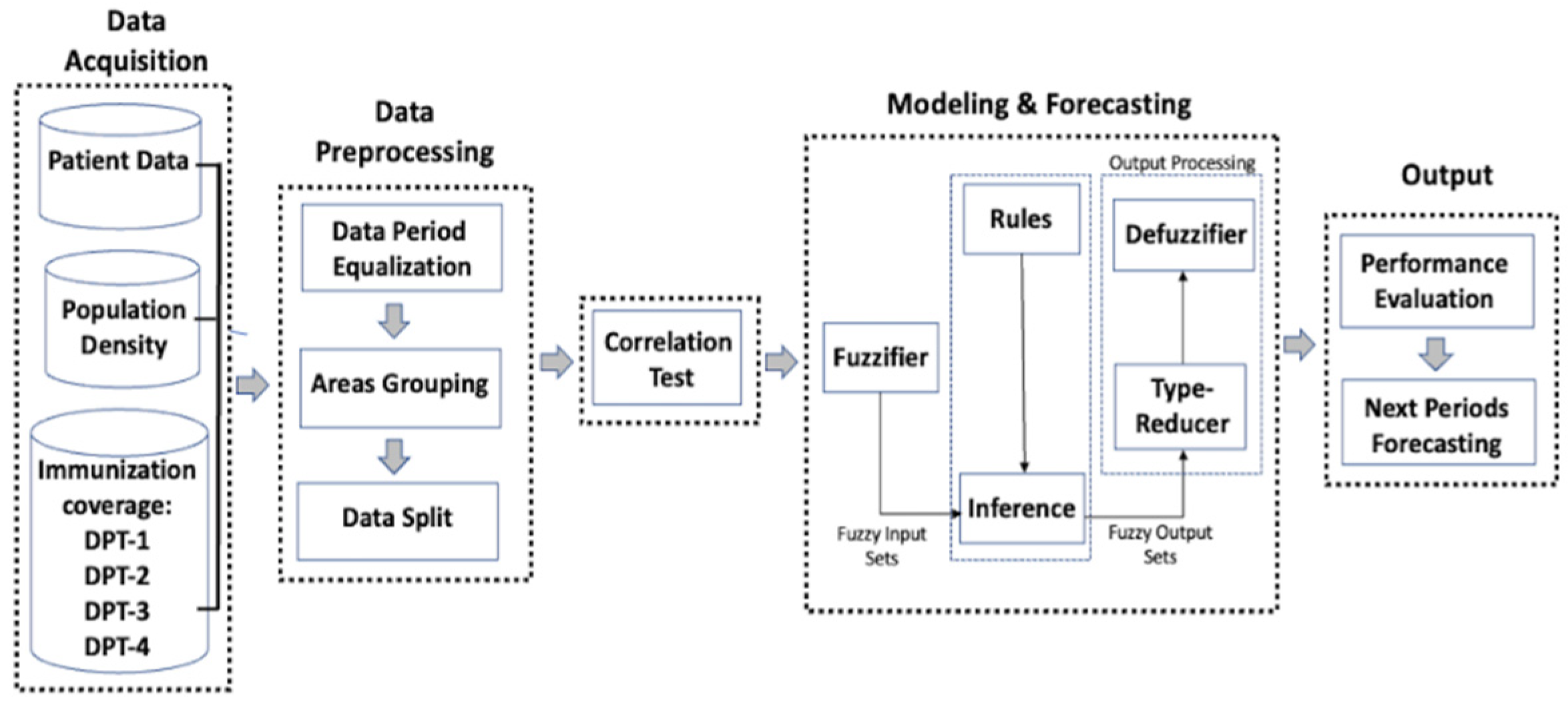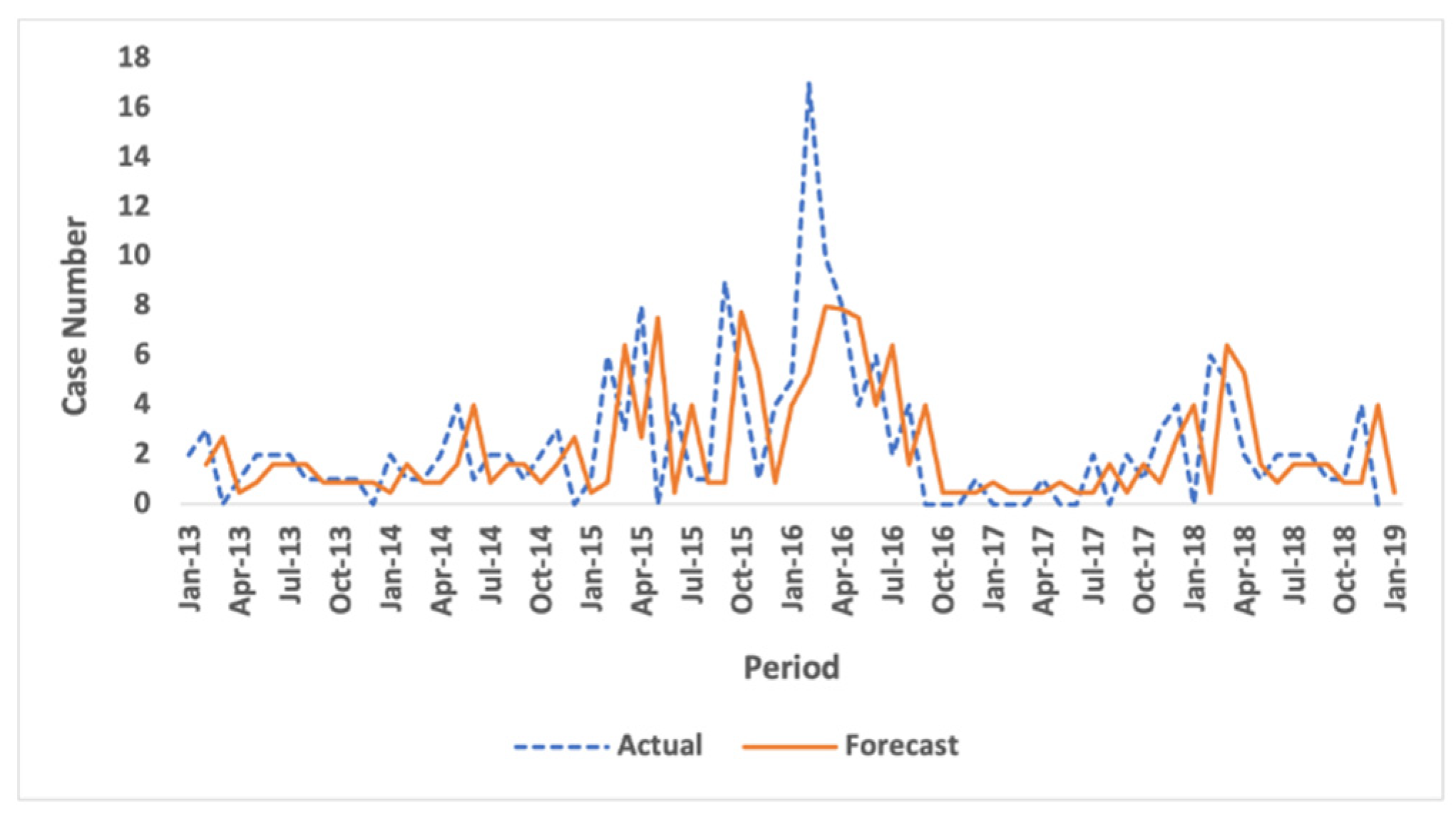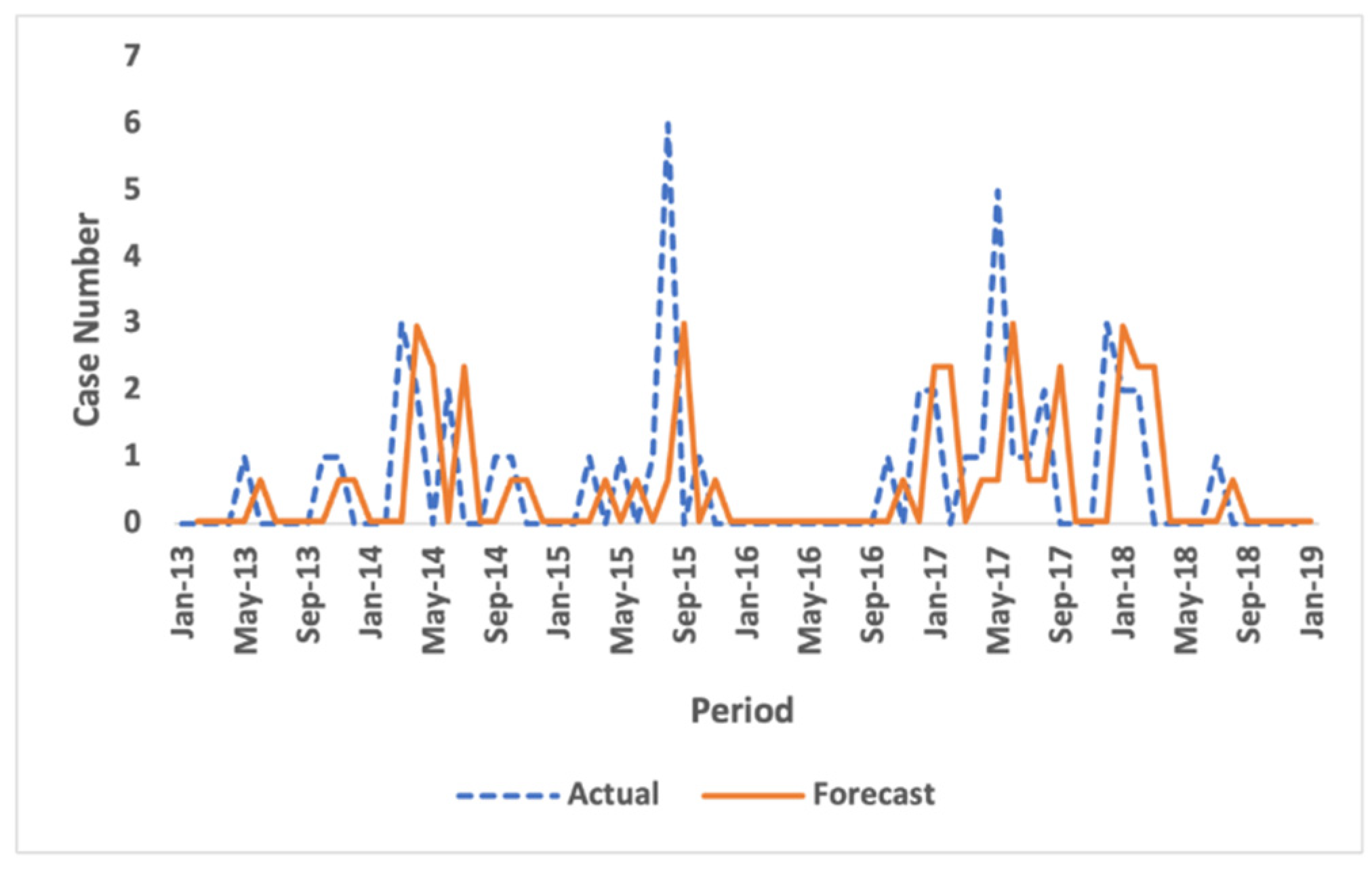Forecasting the Case Number of Infectious Diseases Using Type-2 Fuzzy Logic for a Diphtheria Case Study †
Abstract
1. Introduction
2. Related Works
3. Methodology
3.1. Data
3.2. Methodology
3.2.1. Data Preprocessing
3.2.2. Correlation Test
3.2.3. Modeling and Forecasting
3.2.4. Model Performance Calculations
3.3. Model’s Robustness Test
3.4. Case Number Forecasting in the Next Several Periods
4. Results and Discussion
5. Conclusions
Author Contributions
Funding
Institutional Review Board Statement
Informed Consent Statement
Data Availability Statement
Acknowledgments
Conflicts of Interest
References
- Badell, E.; Alharazi, A.; Criscuolo, A.; Almoayed, K.A.A.; Lefrancq, N.; Bouchez, V.; Guglielmini, J.; Hennart, M.; Carmi-Leroy, A.; Zidane, N.; et al. Ongoing diphtheria outbreak in Yemen: A cross-sectional and genomic epidemiology study. Lancet Microbe 2021, 2, e386–e396. [Google Scholar] [CrossRef]
- Diphtheria|CDC. 9 September 2022. Available online: https://www.cdc.gov/diphtheria/index.html (accessed on 23 February 2023).
- van Seventer, J.M.; Hochberg, N.S. Principles of Infectious Diseases: Transmission, Diagnosis, Prevention, and Control. In International Encyclopedia of Public Health, 2nd ed.; Quah, S.R., Ed.; Academic Press: Cambridge, MA, USA, 2017; pp. 22–39. [Google Scholar] [CrossRef]
- Reid, M.C.; Peebles, K.; Stansfield, S.E.; Goodreau, S.M.; Abernethy, N.; Gottlieb, G.S.; Mittler, J.E.; Herbeck, J.T. Models to predict the public health impact of vaccine resistance: A systematic review. Vaccine 2019, 37, 4886–4895. [Google Scholar] [CrossRef]
- Nicholson, L.; Adkins, E.; Karyanti, M.R.; Ong-Lim, A.; Shenoy, B.; Huoi, C.; Vargas-Zambrano, J.C. What is the true burden of diphtheria, tetanus, pertussis and poliovirus in children aged 3–18 years in Asia? A systematic literature review. Int. J. Infect. Dis. 2022, 117, 116–129. [Google Scholar] [CrossRef]
- Clarke, K. Review of the Epidemiology of Diphtheria 2000–2016. Available online: https://cdn.who.int/media/docs/default-source/immunization/sage/2017/sage-meeting-of-april-2017/background-docs/session-diphtheria/1.-review-of-the-epidemiology-of-diphtheria---2000-2016-pdf-829kb.pdf?sfvrsn=9ba4f061_3 (accessed on 1 June 2023).
- Sujarwo, E. 460 Kasus dan 16 Orang Meninggal, KLB Difteri di Jatim Belum Dicabut [460 Cases and 16 People Died, Diphtheria Outbreak in East Java Has Not Been Re-voked]. Detiknews. Available online: https://news.detik.com/berita-jawa-timur/d-3855026/460-kasus-dan-16-orang-meninggal-klb-difteri-di-jatim-belum-dicabut (accessed on 29 April 2023).
- Bellavite, P. Factors that influenced the historical trends of tetanus and diphtheria. Vaccine 2018, 36, 5506. [Google Scholar] [CrossRef]
- Anggraeni, W.; Nandika, D.; Mahananto, F.; Sudiarti, Y.; Fadhilla, C.A. Diphtheria Case Number Forecasting using Radial Basis Function Neural Network. In Proceedings of the 2019 3rd International Conference on Informatics and Computational Sciences (ICICoS), Semarang, Indonesia, 29–30 October 2019; pp. 1–6. [Google Scholar] [CrossRef]
- Leidere-Reine, A.; Kolesova, O.; Kolesovs, A.; Viksna, L. Seroprevalence of diphtheria and measles antibodies and their association with demographics, self-reported immunity, and immunogenetic factors in healthcare workers in Latvia. Vaccine X 2022, 10, 100149. [Google Scholar] [CrossRef]
- Runkler, T.; Coupland, S.; John, R. Interval type-2 fuzzy decision making. Int. J. Approx. Reason. 2017, 80, 217–224. [Google Scholar] [CrossRef]
- Mittal, K.; Jain, A.; Vaisla, K.S.; Castillo, O.; Kacprzyk, J. A comprehensive review on type 2 fuzzy logic applications: Past, present and future. Eng. Appl. Artif. Intell. 2020, 95, 103916. [Google Scholar] [CrossRef]
- Najafi, A.; Amirkhani, A.; Mohammadi, K.; Naimi, A. A novel soft computing method based on interval type-2 fuzzy logic for classification of celiac disease. In Proceedings of the 2016 23rd Iranian Conference on Biomedical Engineering and 2016 1st International Iranian Conference on Biomedical Engineering (ICBME), Tehran, Iran, 24–25 November 2016; pp. 257–262. [Google Scholar] [CrossRef]
- Gonzales, A.; Choque, D.; Marcos-Carbajal, P.; Salvatierra, G. Factors associated with diphtheria vaccination completion among children under five years old in Peru 2010–2019: A cross-sectional population-based study. Heliyon 2022, 8, e11370. [Google Scholar] [CrossRef]
- Khetsuriani, N.; Zaika, O.; Slobodianyk, L.; Scobie, H.M.; Cooley, G.; Dimitrova, S.D.; Stewart, B.; Geleishvili, M.; Allahverdiyeva, V.; O’Connor, P.; et al. Diphtheria and tetanus seroepidemiology among children in Ukraine, 2017. Vaccine 2022, 40, 1810–1820. [Google Scholar] [CrossRef]
- Verdier, R.; Marchal, C.; Belhassen, M.; Pannerer, M.L.; Guiso, N.; Cohen, R. Coverage rates for diphtheria, tetanus, poliomyelitis, and pertussis age-specific booster recommendations in France: 2018 update of the real-world cohort analysis. Infect. Med. 2022, 2, 51–56. [Google Scholar] [CrossRef]
- Pruitt, S.L.; Tiro, J.A.; Kepka, D.; Henry, K. Missed Vaccination Opportunities Among U.S. Adolescents by Area Characteristics. Am. J. Prev. Med. 2022, 62, 538–547. [Google Scholar] [CrossRef]
- Dadari, I.; Ssenyonjo, J.; Anga, J. Effective vaccine management through social behavior change communication: Exploring solutions using a participatory action research approach in the Solomon Islands. Vaccine 2020, 38, 6941–6953. [Google Scholar] [CrossRef]
- Li, X.; Mukandavire, C.; Cucunuba, Z.M.; Londono, S.E.; Abbas, K.; Clapham, H.E.; Jit, M.; Johnson, H.L.; Papadopoulos, T.; Vynnycky, E.; et al. Estimating the health impact of vaccination against ten pathogens in 98 low-income and middle-income countries from 2000 to 2030: A modelling study. Lancet 2021, 397, 398–408. [Google Scholar] [CrossRef]





| Minimum | Maximum | Mean | Std. Deviation | Skewness | |
|---|---|---|---|---|---|
| Statistic | Statistic | Statistic | Statistic | Statistic | |
| Case_Number | 0 | 17 | 2.09 | 2.722 | 2.304 |
| Population_ Density | 529 | 8232 | 3127.5 | 3.543.534 | 0.711 |
| DPT_1 | 3.13 | 17.1 | 84.352 | 113.736 | 2.433 |
| DPT_2 | 3.23 | 16.29 | 83.390 | 110.404 | 1.626 |
| DPT_3 | 3.51 | 16.35 | 83.053 | 116.969 | 1.931 |
| DPT_4 | 0 | 127.02 | 52.462 | 1.184.238 | 7.710 |
| Input Variable | Output Variable |
|---|---|
| Number of Diphtheria Sufferers Period t | Number of Diphtheria Sufferers Period t + 1 |
| Population Density Period t | |
| Diphtheria-1 Immunization (DPT-1) Coverage Period t | |
| Diphtheria-2 Immunization (DPT-2) Coverage Period t | |
| Diphtheria-3 Immunization (DPT-3) Coverage Period t |
| Combination | MF | Input Variable |
|---|---|---|
| A | 3 | Number of Diphtheria Sufferers Period t |
| 5 | ||
| 7 | ||
| B | 3 | Number of Diphtheria Sufferers Period t Population Density Period t |
| 5 | ||
| 7 | ||
| C | 3 | Number of Diphtheria Sufferers Period t Diphtheria-1 Immunization (DPT-1) Coverage Period t Diphtheria-2 Immunization (DPT-2) Coverage Period t Diphtheria-3 Immunization (DPT-3) Coverage Period t Diphtheria-4 Immunization (DPT-4) Coverage Period t |
| 5 | ||
| 7 | ||
| D | 3 | Number of Diphtheria Sufferers Period t Population Density Period t Diphtheria-1 Immunization (DPT-1) Coverage Period t Diphtheria-2 Immunization (DPT-2) Coverage Period t Diphtheria-3 Immunization (DPT-3) Coverage Period t Diphtheria-4 Immunization (DPT-4) Coverage Period t |
| 5 | ||
| 7 |
| Variable | DPT-1 | DPT-2 | DPT-3 | DPT-4 | K | ||
|---|---|---|---|---|---|---|---|
| 0.485 | 1.000 | ||||||
| DPT-1 | 0.091 | 0.052 | 1.000 | ||||
| DPT-2 | 0.052 | −0.003 | 0.930 | 1.000 | |||
| DPT-3 | 0.042 | −0.033 | 0.894 | 0.944 | 1.000 | ||
| DPT-4 | −0.033 | −0.080 | 0.139 | 0.167 | 0.150 | 1.000 | |
| K | −0.111 | −0.165 | 0.088 | 0.177 | 0.148 | 0.146 | 1.000 |
| Variable | DPT-1 | DPT-2 | DPT-3 | DPT-4 | K | ||
|---|---|---|---|---|---|---|---|
| 0.110 | 1.000 | ||||||
| DPT-1 | −0.086 | −0.114 | 1.000 | ||||
| DPT-2 | −0.035 | −0.063 | 0.959 | 1.000 | |||
| DPT-3 | −0.023 | −0.085 | 0.947 | 0.962 | 1.000 | ||
| DPT-4 | −0.083 | −0.140 | −0.026 | 0.028 | −0.005 | 1.000 | |
| K | 0.959 | 0.026 | −0.200 | −0.190 | −0.196 | 0.675 | 1.000 |
| Variable | DPT-1 | DPT-2 | DPT-3 | DPT-4 | K | ||
|---|---|---|---|---|---|---|---|
| 0.168 | 1.000 | ||||||
| DPT-1 | −0.039 | 0.062 | 1.000 | ||||
| DPT-2 | 0.049 | 0.101 | 0.877 | 1.000 | |||
| DPT-3 | 0.072 | 0.112 | 0.889 | 0.908 | 1.000 | ||
| DPT-4 | −0.002 | −0.028 | −0.125 | −0.129 | −0.141 | 1.000 | |
| K | 0.117 | 0.066 | −0.328 | −0.363 | −0.371 | 0.120 | 1.000 |
| Variable | Malang | Surabaya | Sumenep | |||
|---|---|---|---|---|---|---|
| Upper Limit | Lower Limit | Upper Limit | Lower Limit | Upper Limit | Lower Limit | |
| Number of Diphtheria Sufferers Period t | 0 | 6 | 0 | 16 | 0 | 4 |
| Population Density Period t | 706 | 728 | 8008 | 8183 | 528 | 540 |
| DPT-1 Immunization Coverage Period t | 6.92 | 17.1 | 6.48 | 14.44 | 6.7 | 11.07 |
| DPT-2 Immunization Coverage Period t | 6.97 | 16.29 | 6.21 | 12.17 | 6.43 | 11.04 |
| DPT-3 Immunization Coverage Period t | 7.16 | 16.35 | 6.17 | 13.35 | 6.89 | 11.75 |
| DPT-4 Immunization Coverage Period t | 0 | 10.54 | 0 | 100 | 0 | 127.02 |
| Number of Diphtheria Sufferers Period t + 1 | 0 | 6 | 0 | 16 | 0 | 4 |
| Variables | MF Label | Standard Deviation: Lower | Standard Deviation: Upper | Average |
|---|---|---|---|---|
| Sufferers | Low Number | 0.637 | 0.8493 | 0 |
| Medium Number | 2 | |||
| Many | 4 | |||
| DPT-1 Immunization Coverage | Uneven | 0.6959 | 0.9279 | 6.7 |
| Fairly Even | 8.885 | |||
| Even | 11.07 | |||
| DPT-2 Immunization Coverage | Uneven | 0.7341 | 0.9788 | 6.43 |
| Fairly Even | 8.73 | |||
| Even | 11.04 | |||
| DPT-3 Immunization Coverage | Uneven | 0.7739 | 1.032 | 6.89 |
| Fairly Even | 9.32 | |||
| Even | 11.75 | |||
| DPT-4 Immunization Coverage | Uneven | 20.23 | 26.97 | 0 |
| Fairly Even | 63.51 | |||
| Even | 127.02 |
| K | DPT-1 | DPT-2 | DPT-3 | DPT-4 | ||
|---|---|---|---|---|---|---|
| L | LD | U | U | U | U | |
| L | LD | E | E | E | U | B |
| L | FD | FE | U | FE | U | LD |
| L | HD | U | U | U | FE | LD |
| MN | FD | U | U | U | FE | LD |
| MN | FD | U | U | U | FE | B |
| MN | HD | U | U | U | FE | MN |
| B | LD | U | U | U | U | MN |
| B | FD | U | U | U | U | LD |
| MF | Model | Train | Test | ||
|---|---|---|---|---|---|
| MSE | SMAPE | MSE | SMAPE | ||
| 3 | A.3 | 2.503 | 61.9% | 8.785 | 54.91% |
| B.3 | 2.643 | 57.8% | 11.674 | 99.83% | |
| C.3 | 3.077 | 63.2% | 8.580 | 67.75% | |
| D.3 | 3.418 | 49.8% | 7.300 | 54.37% | |
| 5 | A.5 | 2.475 | 46.4% | 6.368 | 51.56% |
| B.5 | 1.645 | 45.7% | 8.129 | 63.92% | |
| C.5 | 1.854 | 43.1% | 6.327 | 49.75% | |
| D.5 | 1.863 | 44.2% | 5.837 | 46.78% | |
| 7 | A.7 | 2.248 | 62.1% | 9.785 | 67.70% |
| B.7 | 1.411 | 41.1% | 7.579 | 55.02% | |
| C.7 | 2.286 | 44.4% | 6.269 | 45.83% | |
| D.7 | 3.681 | 51.92% | 5.971 | 49.52% | |
| MF | Model | Train | Test | ||
|---|---|---|---|---|---|
| MSE | SMAPE | MSE | SMAPE | ||
| 3 | A.3 | 7.705 | 40.20% | 14.940 | 35.51% |
| B.3 | 8.967 | 64.31% | 45.637 | 99.98% | |
| C.3 | 6.414 | 37.28% | 20.017 | 34.48% | |
| D.3 | 6.309 | 36.01% | 21.039 | 35.57% | |
| 5 | A.5 | 6.633 | 40.43% | 20.037 | 34.80% |
| B.5 | 5.211 | 32.95% | 29.928 | 52.35% | |
| C.5 | 9.133 | 38.85% | 13.657 | 31.02% | |
| D.5 | 5.967 | 34.93% | 27.693 | 36.71% | |
| 7 | A.7 | 6.296 | 35.98% | 20.401 | 39.17% |
| B.7 | 3.780 | 30.38% | - | - | |
| C.7 | 7.072 | 36.39% | 18.256 | 34.40% | |
| D.7 | 4.997 | 33.43% | 25.150 | 35.67% | |
| MF | Model | Train | Test | ||
|---|---|---|---|---|---|
| MSE | SMAPE | MSE | SMAPE | ||
| 3 | A.3 | 1.285 | 76.9% | 2.188 | 67.63% |
| B.3 | 0.838 | 75.4% | 2.126 | 70.87% | |
| C.3 | 1.130 | 85.6% | 1.980 | 68.86% | |
| D.3 | 1.264 | 84.0% | 2.130 | 78.09% | |
| 5 | A.5 | 0.802 | 86.7% | 2.739 | 84.61% |
| B.5 | 0.618 | 85.7% | 2.971 | 91.27% | |
| C.5 | 0.586 | 75.8% | 1.985 | 76.35% | |
| D.5 | 0.572 | 77.0% | 1.891 | 71.02% | |
| 7 | A.7 | 1.310 | 90.6% | 2.527 | 84.88% |
| B.7 | 0.809 | 85.5% | 3.261 | 77.18% | |
| C.7 | 1.078 | 79.0% | 2.545 | 70.86% | |
| D.7 | 1.079 | 90.3% | 2.954 | 75.07% | |
Disclaimer/Publisher’s Note: The statements, opinions and data contained in all publications are solely those of the individual author(s) and contributor(s) and not of MDPI and/or the editor(s). MDPI and/or the editor(s) disclaim responsibility for any injury to people or property resulting from any ideas, methods, instructions or products referred to in the content. |
© 2023 by the authors. Licensee MDPI, Basel, Switzerland. This article is an open access article distributed under the terms and conditions of the Creative Commons Attribution (CC BY) license (https://creativecommons.org/licenses/by/4.0/).
Share and Cite
Anggraeni, W.; Firdausiah, M.; Perdana, M.I. Forecasting the Case Number of Infectious Diseases Using Type-2 Fuzzy Logic for a Diphtheria Case Study. Eng. Proc. 2023, 39, 3. https://doi.org/10.3390/engproc2023039003
Anggraeni W, Firdausiah M, Perdana MI. Forecasting the Case Number of Infectious Diseases Using Type-2 Fuzzy Logic for a Diphtheria Case Study. Engineering Proceedings. 2023; 39(1):3. https://doi.org/10.3390/engproc2023039003
Chicago/Turabian StyleAnggraeni, Wiwik, Maria Firdausiah, and Muhammad Ilham Perdana. 2023. "Forecasting the Case Number of Infectious Diseases Using Type-2 Fuzzy Logic for a Diphtheria Case Study" Engineering Proceedings 39, no. 1: 3. https://doi.org/10.3390/engproc2023039003
APA StyleAnggraeni, W., Firdausiah, M., & Perdana, M. I. (2023). Forecasting the Case Number of Infectious Diseases Using Type-2 Fuzzy Logic for a Diphtheria Case Study. Engineering Proceedings, 39(1), 3. https://doi.org/10.3390/engproc2023039003






